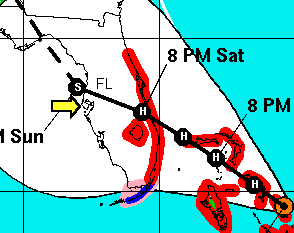Because you simply can't have enough useless posts at almost 3am, here's another. I was thinking about the names and how they go male then female then male. And I was trying to figure out if "Frances" was supposed to be a male or female name.
So I found the 2004 name list:
Alex
Bonnie
Charley
Danielle
Earl
Frances
Gaston
Hermine
Ivan
Jeanne
Karl
Lisa
Matthew
Nicole
Otto
Paula
Richard
Shary
Tomas
Virginie
Walter
Based on the fact that Earl is clearly a man's name (at least gods I hope it is), Frances is supposed to be a woman's name? But yeah, according to various baby name places, it is.
Name: Frances
Gender: female
Origin: Latin, Old French
Meaning: from France, free
Similar Names: Fanchon, Francesca, Fran, Franny, Fanny, Frannie, Francine, Franchesca
Though, bleck, who wants that as a name?
Anyway. Onto the history of hurricane names. For that, I'll give you the National Hurricane Center's info
For several hundred years, hurricanes in the West Indies were often named after the particular saintís day on which the hurricane occurred. For example "Hurricane San Felipe" struck Puerto Rico on 13 September 1876. Another storm struck Puerto Rico on the same day in 1928, and this storm was named "Hurricane San Felipe the second." Later, latitude-longitude positions were used. However, experience has shown that using distinctive names in communications is quicker and less subject to error than the cumbersome latitude longitude identification methods.
Using womenís names became the practice during World War II, following the use of a womanís name for a storm in the 1941 novel "Storm" by George R. Stewart. In 1951 the United States adopted a confusing plan to name storms by a phonetic alphabet (Able, Baker, Charlie), and in 1953 the nationís weather services returned to using female names. The practice of using female names exclusively ended in 1978 when names from both genders were used to designate storms in the eastern Pacific. A year later, male and female names were included in lists for the Atlantic and Gulf of Mexico. The name lists, which have been agreed upon at international meetings of the World Meteorological Organization, have a French, Spanish, Dutch, and English flavor because hurricanes affect other nations and are tracked by the public and weather services of many countries.
The Tropical Prediction Center in Miami, FL keeps a constant watch on oceanic storm-breeding grounds. Once a system with counterclockwise circulation and wind speeds of 39 mph or greater is identified, the Center gives the storm a name from the list for the current year. The letters Q, U, X, Y, and Z are not included because of the scarcity of names beginning with those letters. Names associated with storms that have caused significant death and/or damage are usually retired from the list.
Now, they come up with these things in advance. And they actually recylce them every six years. But, if a storm does major damage, they retire the name and replace it. You can actually see the list through 2009 right here. In fact, there's even a page dedicated to the retirement of names. They take this stuff seriously.
And if all that was too boring, here's a lovely new projection from the National Hurricane Center showing how close the exit point is going to be to me now. *sighs*

yellow arrow = me
What really stinks is that my mom lives just north of me. Pretty much right around the exit point itself. Stupid hurricanes.
I'm going to bed now.